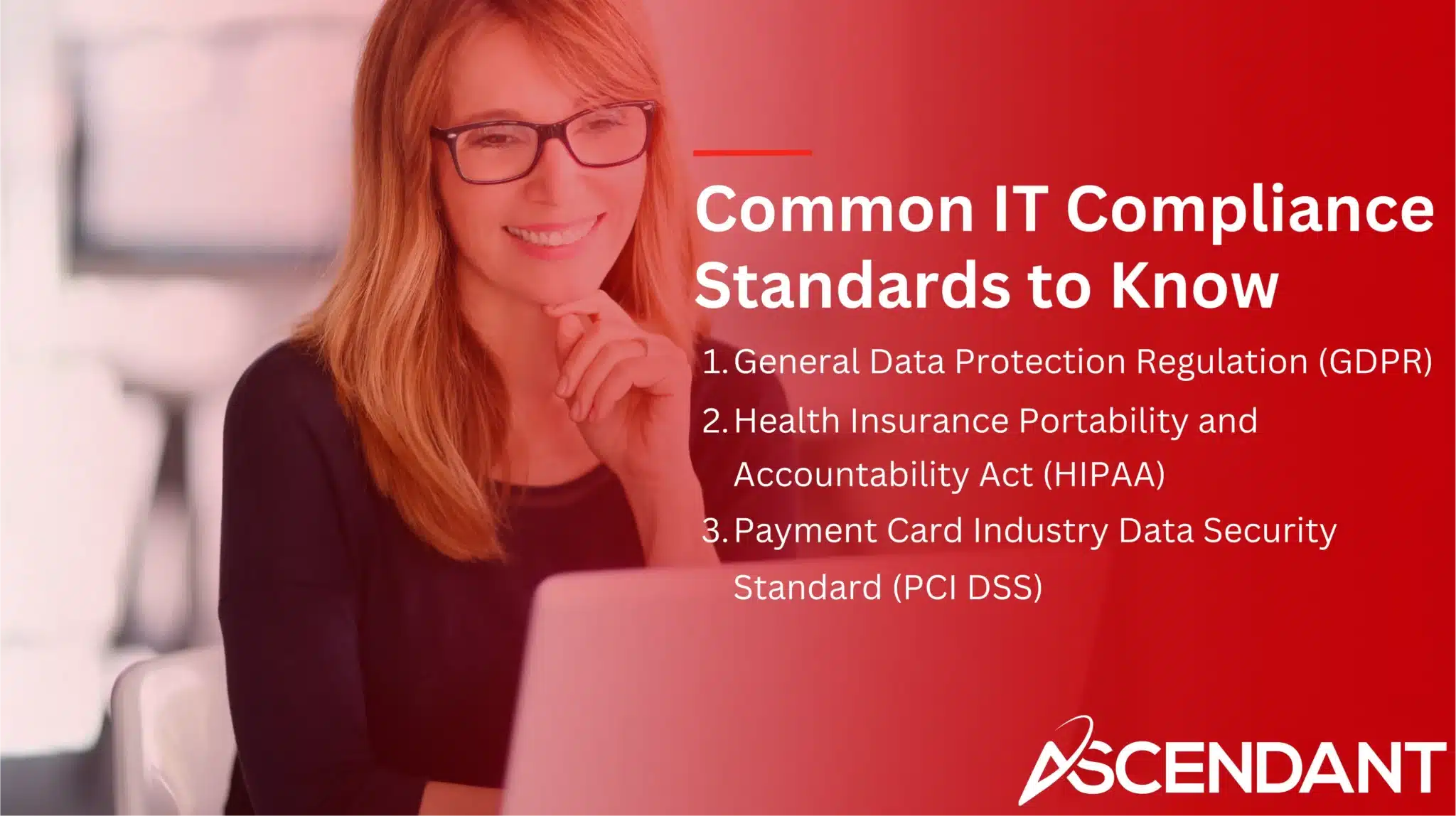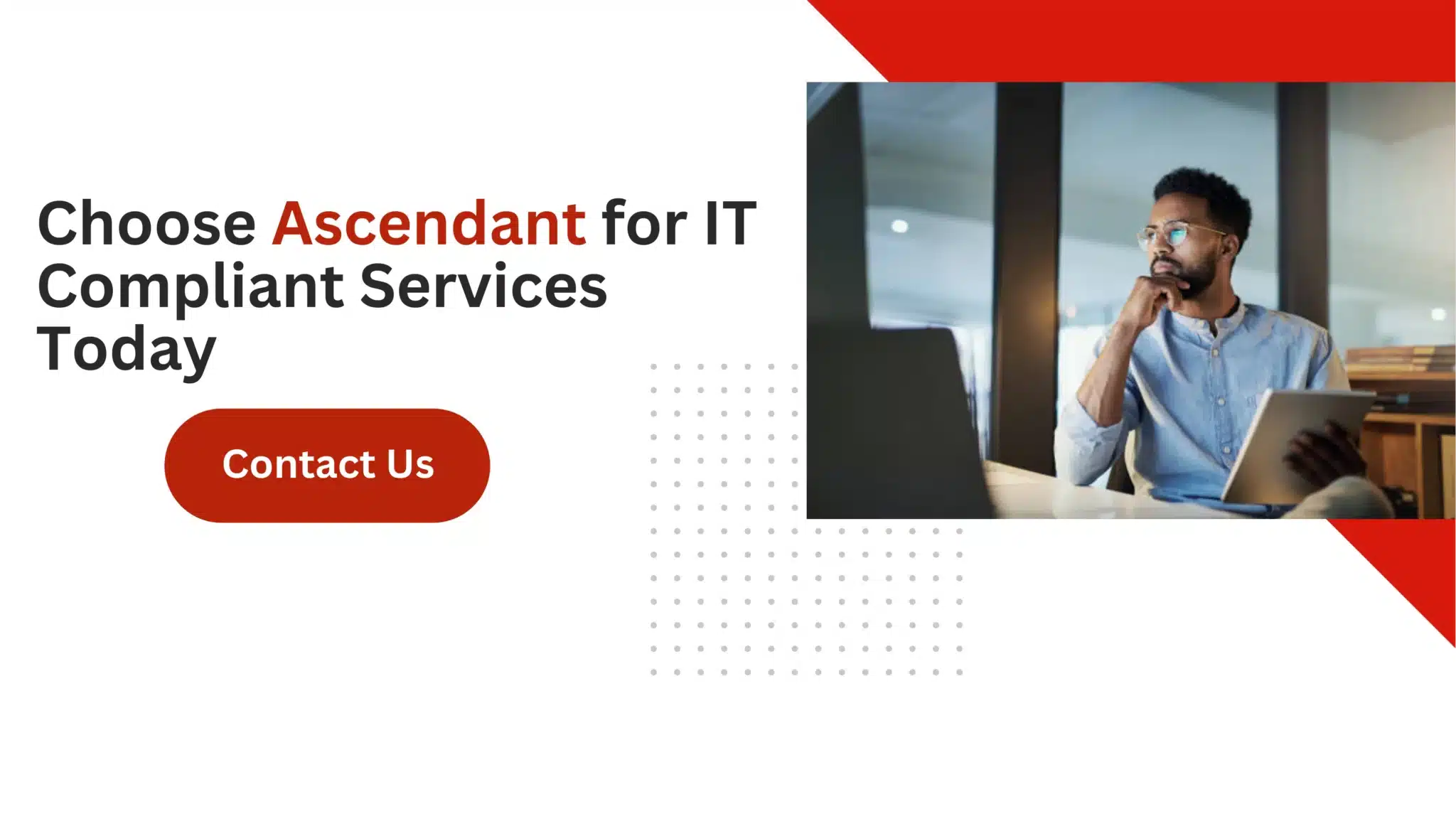IT compliance ensures that an organization adheres to regulations and standards that protect data and secure IT systems. It’s essential to avoid penalties, manage risks, and safeguard sensitive information. This article will explore the fundamentals, benefits, and key risks of IT compliance.
In This Article:
- Understanding IT Compliance
- Key Differences Between IT Compliance and IT Security
- Why IT Compliance is Crucial for Businesses
- Common IT Compliance Standards to Know
- The Role of Compliance Technology
- Benefits of Achieving IT Compliance
- Risks Associated with Non-Compliance
- Steps to Implementing and Effective IT Compliance Program
- How to Maintain Continuous IT Compliance
Key Takeaways
- IT compliance is essential for protecting sensitive data, avoiding penalties, and ensuring organizations adhere to legal and regulatory standards.
- Differences between IT compliance and IT security highlight that compliance focuses on adherence to regulations, while security aims to protect assets from breaches and unauthorized access.
- Non-compliance poses significant financial and reputational risks, making proactive IT compliance management crucial for avoiding costly penalties and maintaining customer trust.
Understanding IT Compliance
Adhering to IT compliance regulations means conforming to a series of established guidelines and norms issued by governing entities aimed at the secure administration of information technology in businesses. These standards encompass a vast array of areas including data protection, cyber defense, and overall governance with the primary objective being the safeguarding of sensitive data within legal and regulatory confines.
Recognizing the importance of meeting these compliance requirements is crucial for organizations looking to steer clear of fines, effectively manage risk exposures, and ensure that their delicate data remains protected. By keeping in step with specified compliance directives, companies not only mitigate potential risks associated with non-compliance, but also promote an environment where IT systems are resilient against threats. Compliance measures serve as safeguards compelling enterprises to abide by necessary legal stipulations thereby circumventing significant financial losses due to security incidents or judicial consequences.
Across its wide-ranging sphere that touches upon aspects like ensuring robustness in cybersecurity protocols and enacting strict controls on how information is managed organizationally—IT compliance places itself firmly as both a requisite under law for business operations and an integral component vital for proficiently managing various kinds of risks related directly or indirectly to handling essential protective tasks around sensitive corporate data.
Key Differences Between IT Compliance and IT Security
Though IT compliance and IT security are frequently discussed together, they fulfill unique yet interconnected roles. IT compliance focuses on conforming to legal and industry mandates, ensuring that it systems adhere strictly to established compliance requirements. This process includes performing compliance audits and maintaining thorough documentation as proof of the organization’s commitment to abiding by relevant industry regulations.
Conversely, IT security is all about safeguarding assets from unauthorized intrusions and breaches using a variety of layered defense mechanisms. While the goal of compliance is alignment with external benchmarks, the purpose of implementing robust security measures is fundamentally about guarding data against both internal and external dangers.
Despite their divergent objectives, there’s a symbiotic relationship between IT compliance and security efforts in mitigating risks associated with non-compliance. Effective administration within this realm necessitates an integrated approach that marries these elements into a comprehensive information security management system that bolsters organizational safety overall.
Why IT Compliance is Crucial for Businesses
The protection and confidentiality of sensitive customer data are pivotal in maintaining consumer trust and fostering loyalty toward an organization. By adhering to IT compliance, a company ensures the integrity of its customer information while building confidence through adherence to regulations such as GDPR or PCI DSS. This demonstrates responsible handling of consumer data, which is vital for retaining customers’ patronage.
Ignoring compliance can result in dire outcomes including damage to the brand’s image, significant financial losses, and strict legal sanctions. The central purpose of IT compliance is to prevent these adverse consequences by following industry standards and established guidelines for regulatory compliance. Organizations that engage proactively in IT compliance management shield themselves from costly fines and safeguard their reputations.
Adherence to compliance doesn’t merely serve as a defense mechanism against negative impacts. It also establishes robust parameters that enhance business security while simultaneously protecting clientele interests—thus mitigating risks overall. Emphasizing the importance of being compliant equips enterprises with better tools for navigating unpredictable challenges while ensuring they stay ahead competitively.
Common IT Compliance Standards to Know
 Maintaining the security and confidentiality of personal and sensitive information within organizations is paramount, necessitating adherence to key compliance standards such as:
Maintaining the security and confidentiality of personal and sensitive information within organizations is paramount, necessitating adherence to key compliance standards such as:
- The General Data Protection Regulation (GDPR)
- The Health Insurance Portability and Accountability Act (HIPAA)
- The Payment Card Industry Data Security Standard (PCI DSS)
Each standard comes with a set of specific requirements tailored to different dimensions of data protection and privacy.
It’s imperative for organizations to fully understand these regulations in order to comply with all legal and regulatory demands. Utilizing a compliance checklist can aid in ensuring that audits confirm alignment with these directives, thereby minimizing risks associated with non-compliance while safeguarding sensitive information.
General Data Protection Regulation (GDPR)
The General Data Protection Regulation (GDPR) is a regulatory framework that oversees how personal data of EU citizens should be handled within the European Union, demanding clear consent from individuals before their information can be processed. GDPR grants people the right to have their data erased and mandates that they are notified in the event of a data breach.
Only personal information necessary for distinct business objectives may be gathered by organizations under this regulation, emphasizing the importance of prioritizing data protection. Compliance with GDPR is crucial not only for safeguarding sensitive information, but also for preserving credibility with consumers and regulatory authorities.
Health Insurance Portability and Accountability Act (HIPAA)
The Health Insurance Portability and Accountability Act, established in 1996, is designed to secure patient data and maintain its confidentiality. It requires that healthcare organizations handling medical data put in place measures aimed at the protection of personal information as well as safeguarding protected health information.
Under HIPAA’s Privacy Rule, all forms of identifiable health-related information managed by entities such as providers and health plans are shielded from unauthorized access, thereby diminishing the likelihood of breaches. Non-compliance with HIPAA can lead to significant civil monetary fines that range between $100 and $50,000 for each record breached, highlighting the critical nature of adhering to these regulations.
Payment Card Industry Data Security Standard (PCI DSS)
The PCI DSS is designed to minimize financial fraud by ensuring the protection of credit card information across different financial institutions. Its main objectives are safeguarding cardholder data, diminishing the likelihood of fraudulent activities, and upholding consumer confidence.
To mitigate the threat of breaches involving cardholder information, businesses engaged in processing, storing or transmitting payment card industry data must adhere to PCI DSS guidelines. This compliance entails adopting vital security measures such as establishing a fortified network and robust access control systems that bolster defense against unauthorized access to sensitive fiscal details.
The Role of Compliance Technology
Compliance technology encompasses systems and software engineered to aid companies in adhering to regulatory requirements with greater efficiency. These technologies facilitate the automation of various functions, such as the oversight of regulations and the orchestration of audit processes, through automated monitoring instruments and compliance management platforms.
Solutions such as Puppet Comply and Helixstorm empower enterprises to fulfill IT compliance by tailoring their offerings to match distinct needs. This suite of technologies often integrates risk evaluation applications, comprehensive compliance management frameworks, assorted compliance aids, and security automation utilities. Their primary purpose is mitigating exposure to compliance risks while optimizing related operations for effectiveness.
Benefits of Achieving IT Compliance
Enhanced data protection is one of the key benefits provided by IT compliance, which in turn builds greater confidence among employees, customers, and stakeholders. By proactively managing security risks to safeguard sensitive information, compliance efforts contribute positively to an organization’s reputation.
Incorporating automated monitoring into these compliance endeavors helps minimize risk exposure while maintaining the efficiency of IT teams and curbing expenses related to security monitoring. Adherence to compliance strengthens standardization and best practices within data management processes, thereby improving both reliability and efficiency overall.
Risks Associated with Non-Compliance
Organizations that violate compliance guidelines may face stiff legal and financial consequences, including severe fines. The monetary impact of failing to comply can be substantial—on average, the losses incurred are 2.71 times greater than the cost of maintaining compliance. Costs associated with non-compliance, such as penalties and legal expenses, can reach into the millions.
Failing to meet cybersecurity regulatory standards can result in punitive measures ranging from monetary fines to operational setbacks and harm to a company’s reputation. Legal actions stemming from non-compliance can interrupt business operations for prolonged periods, thereby hampering productivity and heightening the risk of security breaches.
Aside from financial losses and operational disruptions, neglecting compliance carries considerable risks for an organization’s image by eroding consumer confidence. It is imperative for organizations to follow compliance regulations meticulously in order to prevent data breaches while reducing both compliance risk and cybersecurity threats.
Steps to Implementing an Effective IT Compliance Program
Creating a robust IT compliance program requires aligning operational processes with both industry standards and legal mandates to guarantee that business activities are conducted within the law. To steer these compliance efforts, explicit policies and procedures must be in place, while a designated compliance officer should oversee adherence and ensure responsibility.
Compliance initiatives frequently lead companies to refine their workflows and manage control systems better, which can enhance overall operational efficiency. Maintaining open lines of communication is essential for effectively reporting issues related to compliance practices. It’s important to have detailed documentation on compliance matters as well as clear disciplinary protocols for upholding standards consistently.
Taking swift remedial measures upon identifying any non-compliance issues is critical in preserving the integrity of the IT compliance framework. Such actions facilitate effective handling of potential risks associated with non-compliance and promote ongoing adherence to regulatory expectations.
How to Maintain Continuous IT Compliance
To ensure consistent IT compliance, it is necessary to conduct regular evaluations and checks that confirm sustained conformity with established norms. Periodic auditing and oversight are crucial in pinpointing discrepancies and guaranteeing regulatory compliance.
It’s vital for staff members to undergo continuous training and education to comprehend their duties concerning compliance requirements. Employing automated tools for compliance can simplify the tracking and documentation processes, allowing organizations to concentrate on strategic planning for effective compliance management while upholding persistent adherence to these standards.
Summary
To summarize, safeguarding sensitive data, cultivating trust, and avoiding harsh fines are fundamental reasons why IT compliance is critical. Grasping the distinct aspects of compliance versus security, acknowledging vital common standards, utilizing technology geared towards compliance, and instituting solid programs for compliance enable organizations to sustain ongoing conformity with regulations. It’s imperative for businesses to emphasize IT compliance endeavors as a strategy for protection and securing enduring prosperity.
 Frequently Asked Questions
Frequently Asked Questions
What is IT compliance?
Adhering to the regulations and standards set by governing bodies for secure information technology management in organizations is essential to IT compliance. This conformity is vital for upholding security and trust.
How does IT compliance differ from IT security?
IT compliance is centered on adhering to legal and regulatory standards for IT systems, whereas IT security is primarily concerned with protecting those systems from breaches and unauthorized access.
Both are critical, but they address different aspects of IT management.
Why is IT compliance important for businesses?
IT compliance is essential for businesses as it helps avoid penalties, manages risks, protects sensitive data, and sustains customer trust.
Prioritizing compliance not only ensures regulatory compliance, but also fosters a secure operational environment.
What are some common IT compliance standards?
Various dimensions of data security and privacy are addressed by IT compliance standards like GDPR, HIPAA, and PCI DSS to ensure that organizations conform to legal and regulatory requirements in their practices.
Upholding these regulations is essential for safeguarding sensitive information and preserving stakeholder confidence.
How can organizations maintain continuous IT compliance?
Organizations need to uphold persistent IT compliance by performing frequent evaluations and audits, delivering training for their staff, and implementing tools that automate compliance processes.
Such a forward-thinking strategy guarantees sustained conformity with regulatory requirements and industry standards.

